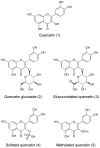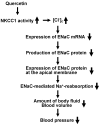Actions of Quercetin, a Polyphenol, on Blood Pressure
- PMID: 28146071
- PMCID: PMC6155806
- DOI: 10.3390/molecules22020209
Actions of Quercetin, a Polyphenol, on Blood Pressure
Abstract
Disorder of blood pressure control causes serious diseases in the cardiovascular system. This review focuses on the anti-hypertensive action of quercetin, a flavonoid, which is one of the polyphenols characterized as the compounds containing large multiples of phenol structural units, by varying the values of various blood pressure regulatory factors, such as vascular compliance, peripheral vascular resistance, and total blood volume via anti-inflammatory and anti-oxidant actions. In addition to the anti-inflammatory and anti-oxidant actions of quercetin, we especially describe a novel mechanism of quercetin's action on the cytosolic Cl- concentration ([Cl-]c) and novel roles of the cytosolic Cl- i.e.: (1) quercetin elevates [Cl-]c by activating Na⁺-K⁺-2Cl- cotransporter 1 (NKCC1) in renal epithelial cells contributing to Na⁺ reabsorption via the epithelial Na⁺ channel (ENaC); (2) the quercetin-induced elevation of [Cl-]c in renal epithelial cells diminishes expression of ENaC leading to a decrease in renal Na⁺ reabsorption; and (3) this reduction of ENaC-mediated Na⁺ reabsorption in renal epithelial cells drops volume-dependent elevated blood pressure. In this review, we introduce novel, unique mechanisms of quercetin's anti-hypertensive action via activation of NKCC1 in detail.
Keywords: Na+-K+-2Cl− cotransporter 1; cytosolic Cl− concentration; epithelial Na+ channel; flavonoid; quercetin.
Conflict of interest statement
The authors declare no conflict of interest.
Figures





References
-
- Endale M., Park S.C., Kim S., Kim S.H., Yang Y., Cho J.Y., Rhee M.H. Quercetin disrupts tyrosine-phosphorylated phosphatidylinositol 3-kinase and myeloid differentiation factor-88 association, and inhibits MAPK/AP-1 and IKK/NF-κB-induced inflammatory mediators production in RAW 264.7 cells. Immunobiology. 2013;218:1452–1467. doi: 10.1016/j.imbio.2013.04.019. - DOI - PubMed
Publication types
MeSH terms
Substances
LinkOut - more resources
Full Text Sources
Other Literature Sources
Medical

